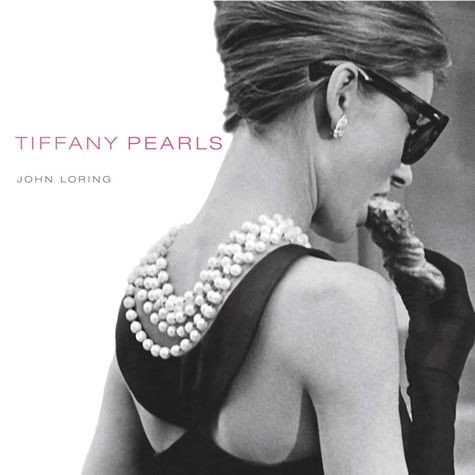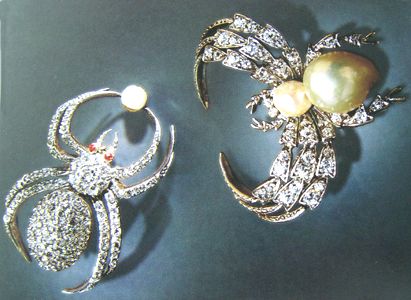It’s the role of colored gems in history which greatly fascinates John Loring, and that’s also reflected in this book. He states, “Jewelry has always been important. As we know, before it was more common for people to own jewels, it was the provenance of royalty, mostly.” He goes on to say, “There were historic expositions inParis, Chicago and St. Louis in the late 19th and early 20th centuries for the average person to see precious gems up close.” As America and Americans became more affluent, these exhibits helped to fuel their desire for gems. Even as recently as the 1939 World’s Fair in New York, Tiffany & Company produced some exquisite jewels. And the fashion magazines at the time were consumed by it. “The presence featured a use of colored gems that were not the big three colors, sapphire, emeralds and rubies. But, remember, the world was sliding into WWII, so it not the best time financially for people to buy any gems,” Loring remarks. “At that time, jewels with designs of large scrolls were popular, as well as the use of aquamarines, citrines and the morganite.”
Tiffany’s really hit its stride in popular culture when Schlumberger started designing for the company in the late 1950s. Still collector’s items, he used different types of colored gems abundantly in his designs. “One of them was the famous “bird on a rock” setting, the setting for the world famous Tiffany Diamond. Schlumberger also created the amazing enamel bracelets that became a staple of stylish wardrobes everywhere. Jacqueline Kennedy was so often photographed wearing them that the press called them the “Jackie “ bracelets, says Texas’ Tiffany and Company general manager Scott Shibley. “All his pieces are absolutely extraordinary,” offers Loring. “He loved the idiosyncratic in nature – the flora and fauna. He also loved incorporating island themes with fish, sea creatures, and birds. He used all sorts of gems, and not all were large. He used lots of big rubies and sapphires and really liked more exotic colored gemstones.” Loring shares that Schlumberger jewels “contained all sorts of stone. Like the one of the bird on the rock in citrine. It’s beautiful, but not overly expensive.” Loring notes it’s not for sale, though, as it is a highly coveted collector’s pieces, as are all of Schlumberger’s creations for Tiffany. Loring also notes that “Schlumberger delighted in using all gems Mother Nature provided. His more complex gems are used on a larger scale. They aren’t appropriate for everyone.” Yet the cover of the book has a Schlumberger piece, which makes quite a statement. “Keep in mind that Schlumberger really invented this whole great thing. These pieces that seem like they have been in the family for centuries, but it’s only been around 70 years.
Other designers who Loring has added to the mystique of the Tiffany brand are women like Elsa Perretti and Paloma Picasso. “With Elsa’s jewelry, they become a part of the woman’s body. She took the oldest female symbol, the heart, which was quite clever and made it special in her designs. She thought of that’” says Loring. “She began using colored gems when she started in 1974 with small rubies, emerald and sapphires. Then she did those lacquered pieces. To her, form is important than color. She’s just as happy with gold and silver to create her designs that are sensual, tactile sculptural.”
Loring met Paloma Picasso in Paris when she was 16 because he was great friends with her mother. “Whereas Schlumberger referenced surrealism in his designs, Paloma avoided that… because that was her father’s territory,” Loring says. Paloma Picasso’s father who is, arguably, the greatest modern artist of the 20thcentury, must have evoked an artistic point of view in his daughter. “She used simple markings that did not imply art – the X’s and scribbles – they were human markings. Paloma has been careful not to go too far into the artistic character.” He adds, “Paloma has a very uplifting presence. She is aggressively chic and stylish. And has a great sense of humor and a joy in living. Good old Joi de Vivre, just like her father had. She’s tremendously great fun.” Paloma Picasso complements that by saying, “I do what I love most, which is designing jewelry. And what I love most about colored stones is that they come from the earth. That’s important to me.” Even Frank Gehry, who also designs for Tiffany, and is known for his clean designs, uses colored gemstones. “He’s one of the world’s greatest architects. His designs have a more sculptural quality. He uses stones like agates and pink opal, not faceted gem stones,” adds Loring.
But really, just who is the kind of woman who loves wearing colored gem stones? John Loring answers the question definitively. “She’s self-assured… has a really good sense of self image. She’s not shy whatsoever and is happy to project her good points as a gift to other people. She loves entertaining others and doesn’t understand wallflowers. Whether she is young or older, her presentation of herself and jewels reflects her generosity of spirit,” Loring confides.
John Loring knows about generosity of spirit. As Design Director, author, international scene maker, and all-around beloved style arbiter, there seems to be no end to his perpetuating the Tiffany brand in the luxury universe in books and elsewhere. “When I go to write these books, to me it is about the historical part that I am so very interested in, having living in Europe so long. Like the chapter that includes Charles the Bold in Rouge. It all rings familiar growing up there,” Loring shares. “I have a great deal more enthusiasm when I start researching theses stories that include these jewels – the palaces they built, the battles that were fought over them. Plus, it’s exciting to see who owned and wore all these great jewels. It’s great human drama.”



